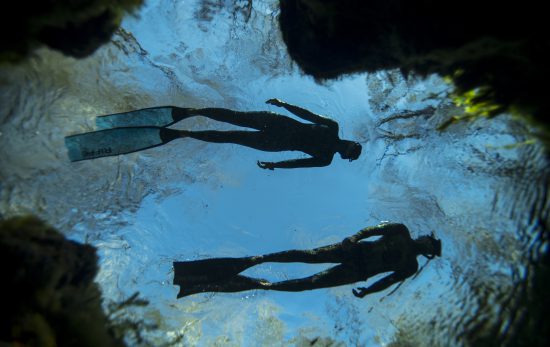Narwhals are one of the ocean’s most mysterious and misunderstood creatures. A surprising number of people don’t believe narwhals exist, or believe narwhals are extinct. Learn the truth and some fun facts about this very special creature.
Yes, Narwhals are Real
Almost 15,000 people per month search “are narwhals real” on Google. Perhaps the narwhal’s nickname “unicorn of the sea,” lends to its mythical status?
Narwhals live in the Arctic near loose pack ice and areas of open water known as polynya (pol-en-ya). They eat cod, halibut, herring, shrimp and squid. Narwhals are skittish, spend much of their time deep beneath the ice and don’t live long in captivity, so scientists don’t know much about them compared to other whales.
A recent tagging program provided some data about narwhal behavior. On average, narwhals spend more than three hours per day below 800 meters/2600 feet. At this depth, atmospheric pressure can exceed 151 bar/2200 PSI (150 atmospheres) and it’s extremely dark. One animal dove down to 1,776 metres/5,827 feet (more than a mile) beneath the ice…and then the tracker broke.

That’s Not a Horn
The narwhal “horn” is actually a tusk. Most male narwhals (and some females) are born with two enlarged teeth, but only one protrudes through their head. In reality, the narwhal is more of a walrus than a unicorn of the sea!
During the Middle Ages, narwhal tusks were sold as unicorn horns and thought to be magical. Today, the narwhal’s tusk is still a bit mysterious. Here’s what we know:
– About 15 percent of female narwhals grow a tusk
– Some narwhals have two tusks
– An average tusk is 2.4m/8 feet but can grow up to 3m/10ft
– The tusk grows in a counterclockwise spiral
– It can bend up to a foot without breaking
– Narwhals have the only straight tusk in the animal kingdom
(elephant and walrus tusks are curved)

Contrary to popular belief, narwhals don’t use their tusks to duel. A narwhal’s tusk contains up to 10 million nerve endings and living pulp. It’s so sensitive, some scientists describe it as an “inside out tooth.” Narwhals have been observed touching tusks, but not in a hostile or aggressive way. It’s possible they run tusks to help each other remove algae growth.
The tusk isn’t used to spear fish, but they do use it to hunt. Recent drone footage shows a narwhal using its tusk to stun a fish before eating it.
Narwhals may use their tusk to sense barometric pressure, water temperature, or salinity. It’s possible they also use it for echolocation. Whatever the tusk does, it isn’t essential to the animal’s day-to-day survival because most female narwhals don’t have one.
Narwhals are Smart and Well-Adapted
Narwhals are extremely well-adapted to their environment. They don’t have a dorsal fin, which means they can swim directly under the ice, and they manage to find food and breathing holes in a cold, dark environment. A narwhal needs to surface every four to six minutes in order to breathe. Dr. Kristin Laidre, Principal Scientist at the Polar Science Center, told The New York Times, “You don’t see open water for miles and miles and suddenly there’s a small crack, and you’ll see narwhals in it.”
Research suggests narwhals are also fairly smart. A narwhal’s brain is the same size as a human’s (relative to body mass), and they can recognize themselves in a mirror and pass along new skills to younger generations.
Narwhals tend to congregate in groups of 20-30 and some like to hang out with their French-Canadian cousins.
Climate Change is a Major Threat
Orcas and polar bears are the narwhal’s natural predators, but climate change and declining fish populations are their greatest threat to survival. Research by the University of Washington and the University of Alaska Fairbanks found narwhals are the marine mammal least likely to survive the loss of ice floes.
Learn more about narwhals and see some great narwhal comics by visiting the University of Washington’s Narwhal FAQ. Want to see narwhals in the wild? Get your PADI® Dry Suit Diver specialty, and contact your local PADI Dive Center or PADI Travel™ to book a liveaboard trip to the Arctic.


